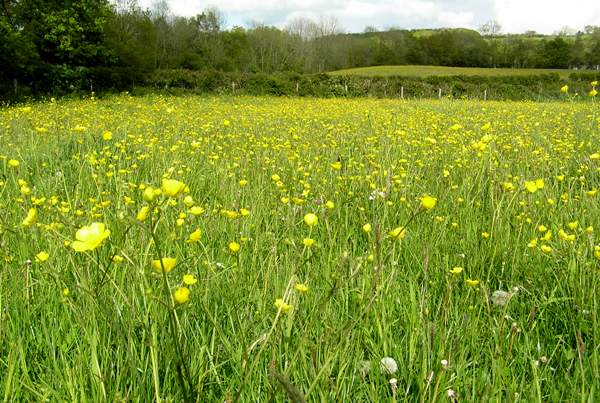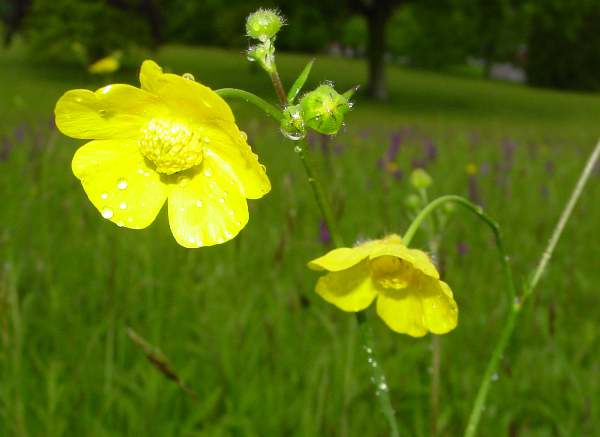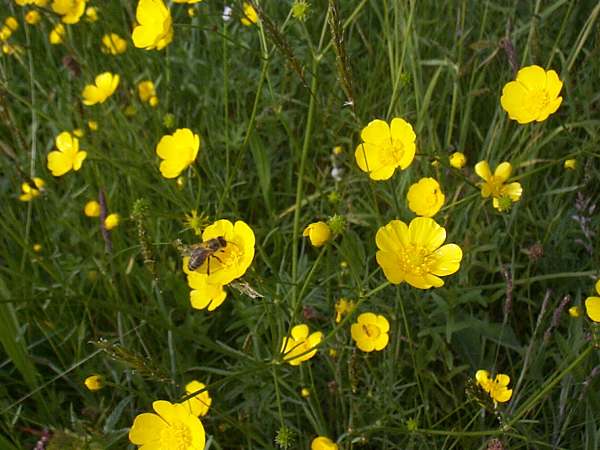Ranunculus acris - Meadow Buttercup
Phylum: Magnoliophyta - Class: Equisetopsida - Order: Ranunculales - Family: Ranunculaceae

Who is not stopped in their tracks by the sight of a beautiful buttercup meadow? Children today still play the game of finding out if their playmates like butter by holding a buttercup flower under their chin; if the golden yellow is reflected on the skin, the answer is 'Yes!'
Description
One of the best known of wildflowers, the Meadow Buttercup is tall and stately, and quite the perfect yellow for playing 'Do you like butter?'

Meadow Buttercup usually grows to a height of about 75cm but can reach a metre or more. This hairy perennial has toothed, palmate lower leaves and a few lanceolate leaves at flower stalk junctions. Flowers are borne singly on unfurrowed stalks branching from stems, with a terminal flower on a stem rather longer than the others. Each flower usually has five rounded sepals - there are no true petals, but most people use the term petals when describing these flowers - forming a shallow cup 1.5 to 2.5cm across that gradually flattens out. Seeds are produced in star-like achenes (segmented seed pods).
Distribution
Widespread and common throughout Britain, Ireland and most of northern and central mainland Europe, Ranunculus acris is also native to parts of asia. This buttercup is also present in Australia, New Zealand and North America.

Habitat
It's in the common name, of course: these are wildflowers of damp permanent-pasture meadows, but they can also produce impressive stands on grassy roadside verges.
Blooming Times
Ranunculus acris blooms in Britain and Ireland from April until October and is generally at its best from May to July.
Uses
Buttercups contains an irritant latex that can cause very unpleasant reactions in farm animals and in people. The acrid taste of Meadow Buttercups (and indeed to a degree nearly all common buttercup species except the Goldilocks Buttercup Ranunculus auricomus) seems to be sufficient deterrent, as there have been only a few cases of serious poisoning.
There is a risk to farm animals if they are left too long in a buttercup meadow, because when there is no grass left they might have to settle for buttercups, and become very 'unsettled' as a result. Despite these safety concerns, buttercups are sometimes used in herbal treatments for arthritis, bronchitis and several other ailments. (We strongly advise against eating or using as medicines any plants without first obtaining qualified professional advice.)
Etymology
The genus name Ranunculus comes from the Latin rana, meaning frog, while the suffix -culus indicates the diminutive form - hence Ranunculus means 'little frog'. The most likely explanation is that both frogs and Ranunculus wildflower species are usually found in damp places. The specific epithet acris means bitter tasting (as in acrid). Folklore has it that, because of the yellow of the buttercups, cows grazing in buttercup-richmeadows provided the finest butter.
Similar Species
There are many other buttercup species. Creeping buttercup Ranunculus repens is often found in lawns and gardens, while the bulbous buttercup Ranunculus bulbosus is another farmland species.
The pictures of Meadow Buttercup shown on this page were taken in West Wales and in Somerset during May.
Sue Parker's latest ebook is a revised and enlarged second edition of the acclaimed Wildflowers in the Algarve - an introductory guide. Full details here...
Buy it for just £3.95 on Amazon...
Please Help Us: If you have found this information interesting and useful, please consider helping to keep First Nature online by making a small donation towards the web hosting and internet costs.
Any donations over and above the essential running costs will help support the conservation work of Plantlife, the Rivers Trust and charitable botanic gardens - as do author royalties and publisher proceeds from books by Pat and Sue.



